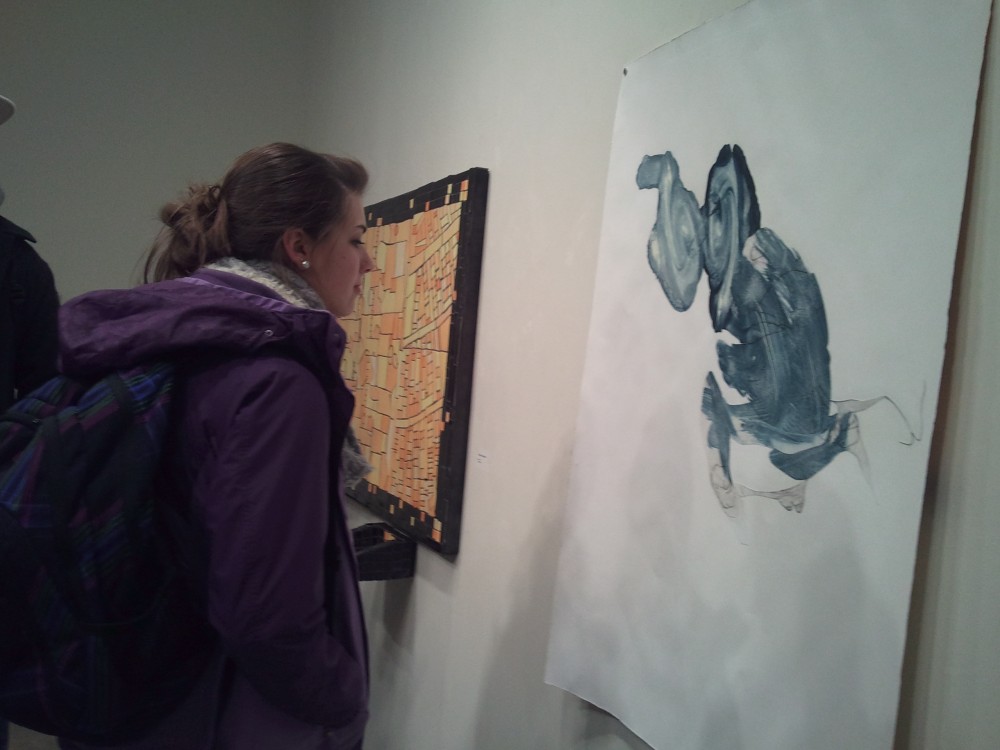Mother Nature in mind

Fresman Samantha Stevens engages with a piece by student artist Julia Victor entitled “Vortex” at the Landed exhibit.
Feb 3, 2011
For many patrons and producers of art, landscapes are a traditional and essential niche. But for the 15 artists behind Grand Valley State University’s “Landed” student exhibition, the traditional form of landscape is in need of change.
Senior painting student Jessi Essian, who helped organize the exhibit and selected its landscape theme, said people tend to have traditional images of what landscape art should look like. Landscapes often portray distant views of open fields, rustic forests or breezy beach scenes, among other idyllic vistas.
“We tend to put this type of art into a box and think a landscape is supposed to look a certain way,” Essian said.
However, she added “Landed,” the collaborative student show that runs until 6 p.m. tonight, aims to offer different ways of viewing the land. Fifteen artists offer unique perspectives of land and environment through the use of various materials and methods. The exhibit, held in the Padnos Student Gallery in the Calder Art Center, showcases student artists’ prints, paintings, sculptures and more.
“A lot of people may not understand abstract art because it is not all in front of you,” said senior printmaker Amanda Wieczorek, whose untitled steel plate etching is featured in the show. “With traditional landscape, it is very recognizable. It’s good to break free of what we’re used to seeing. We use our imagination a little more.”
Student gallery assistant Rachel Kauff, a senior printmaker who also helped run the exhibit, said traditional landscapes tend to depict land as property to lend humans a sense of control.
“We start to only see land as a resource for our use and not as something sustaining us,” Kauff said. “Stepping away from that allows us to see land through actual experience. This is an interesting way to challenge what we think about visual depictions of land.”
To break traditional thinking, senior Krista Awad’s exhibit oil painting, “Honeycomb Intestines,” transforms the human body into a landscape by illustrating how it functions as its own environment.
“Just because a tree looks like that doesn’t mean it always has to look that way,” said Awad, who specializes in abstract landscapes. “Humans have creative minds. We are the only species with imagination. It needs to be shown that this is what imagination is capable of.”
In addition to stretching viewers’ imaginations, Essian said the exhibit is meant to reconnect people with their surrounding environments.
“People can still hold that meaningful relationship, if they take the time,” she said. “This show is a reminder of the experiences and relationships we can have with land.”
Brian Westrick, a senior with an emphasis in ceramics, said landscapes have prevailed in art forms because they make viewers realize their perspective in relation to nature. His ceramics exhibit piece, “Graces,” is a wearable work of art that aims to show the power of nature to influence human actions and emotions.
And in an age of increasing development and pollution, Westrick said exposure to such nature-based art will continue to impact the contemporary world.
“I believe that it is always important to know where and how you relate to your environment,” he said. “People need to recognize the natural beauty of the land and look to preserve it.”

























